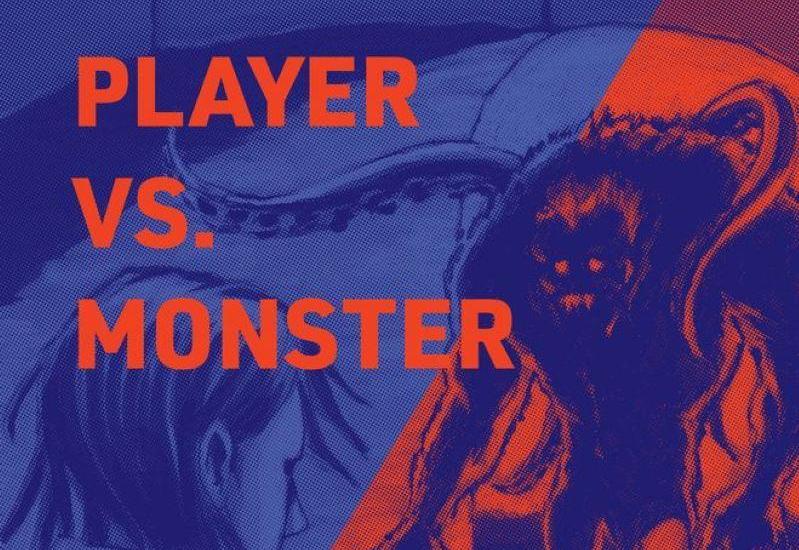A study of the gruesome game characters we love to beat—and what they tell us about ourselves.
Since the early days of video games, monsters have played pivotal roles as dangers to be avoided, level bosses to be defeated, or targets to be destroyed for extra points. But why is the figure of the monster so important in gaming, and how have video games come to shape our culture’s conceptions of monstrosity? To answer these questions, Player vs. Monster explores the past half-century of monsters in games, from the dragons of early tabletop role-playing games and the pixelated aliens of Space Invaders to the malformed mutants of The Last of Us and the bizarre beasts of Bloodborne, and reveals the common threads among them.
Covering examples from aliens to zombies, Jaroslav Švelch explores the art of monster design and traces its influences from mythology, visual arts, popular culture, and tabletop role-playing games. At the same time, he shows that video games follow the Cold War–era notion of clearly defined, calculable enemies, portraying monsters as figures that are irredeemably evil yet invariably vulnerable to defeat. He explains the appeal of such simplistic video game monsters, but also explores how the medium could evolve to present more nuanced depictions of monstrosity.
让我们研究一下那些我们乐于在游戏中击败的坏家伙,及其对我们自身的启示吧。
从电子游戏刚出现没多久,怪兽就一直在游戏中扮演着重要角色。它们意味着应该避开的危险、需要战胜的关卡首领,或摧毁后能获得额外奖励的目标。那么,为什么怪兽形象在游戏中如此重要,电子游戏又说如何塑造了文化中的怪物概念呢?为了回答这些问题,《玩家VS怪兽》探索了过去半个世纪的游戏中出现过的怪兽,从早期的角色扮演类桌面游戏里的龙,像素游戏《太空侵略者》中的外星生物,到《最后的生还者》中的畸变突变体,以及《血源》中的奇异野兽,来揭示它们之间的共同线索。
作者例举了从外星生物到僵尸等多种怪物,探索追溯了怪兽设计的艺术及其从神话、视觉艺术、流行文化和桌面角色扮演游戏等方面受到的影响。同时他还指出,电子游戏也遵循了冷战时期的概念——即敌人是有明确定义且可被计算的——怪兽也被塑造为不可救药的邪恶形象,但又很容易被击败。作者对这种简单化的电子游戏怪兽为何会吸引人做出了解释,同时还探讨了媒介如何进化以更细致入微地刻画怪兽的形象。
本书简体中文版由恒先文化引进出版,预计于 2025 年初上市,敬请期待!

作者简介 Author
Jaroslav Švelch is Assistant Professor in the Department of Media Studies at Charles University, Prague, and Lecturer in the Department of Game Design at the Film and TV School of Academy of Performing Arts in Prague. He is the author of Gaming the Iron Curtain: How Teenagers and Amateurs in Communist Czechoslovakia Claimed the Medium of Computer Games.
雅罗斯拉夫·斯维尔奇(Jaroslav Švelch ), 捷克布拉格查尔斯大学媒体研究系助理教授,布拉格表演艺术学院电影电视学院游戏设计系讲师。他出版过有关电子游戏历史和理论、游戏与社交媒体幽默的著作,包括《铁幕游戏:共产主义捷克斯洛伐克的青少年和业余爱好者如何占据电脑游戏媒介》等,个人信息可参看。
评价 Praise
“Švelch shows us how monsters in video games are created, where they run rampant, what they mean, and how we came to kill them, enabling us to make sense of such monstrosities with intelligence and wit.”
—— Bernard Perron, Full Professor of Film and Game Studies at Université de Montréal; author of The World of Scary Video Games
“斯维尔奇向我们展示了电子游戏中的怪兽是如何被创造的,它们在哪里横行,它们代表什么,以及我们是如何消灭它们的。这让我们能够以聪明和机智的方式理解这些怪兽。”
——贝尔纳·佩隆(Bernard Perron),《恐怖电子游戏的世界》作者,蒙特利尔大学电影与游戏研究专业正教授
“The book elegantly reveals the running tensions and contradictions in the figure of the monster and how games transform their cultural meaning, combining academic elegance and rigor in equal measure.”
—— Clara Fernández-Vara, Associate Arts Professor at the NYU Game Center
“这本书巧妙地揭示了始终存在于怪兽形象中的紧张与矛盾,以及游戏如何让这些形象的文化含义发生改变,实现了学术中优雅与严谨的平衡结合。”
——克拉拉·费尔南德斯-瓦拉(Clara Fernández-Vara),纽约大学游戏中心艺术副教授
“Švelch casts the ubiquitous figure of the videogame monster under a sharply critical, historically informed analytical lens. What emerges is a radical new understanding of monstrosity and otherness as constitutive of videogames’ form and meaning.”
—— Daniel Vella, Senior Lecturer, Institute of Digital Games, University of Malta; coauthor of Virtual Existentialism
“斯维尔奇将电子游戏中无处不在的怪兽形象置于尖锐批判和历史分析视角之下,这是一种对怪异性和他者性作为电子游戏的形式和意义之构成的全新理解。”
——丹尼尔·韦拉(Daniel Vella),《虚拟存在主义》作者(合著),马耳他大学数字游戏研究所高级讲师

